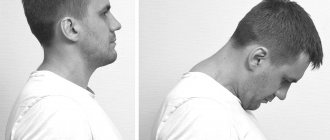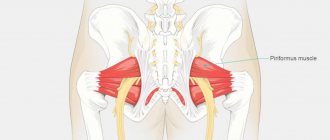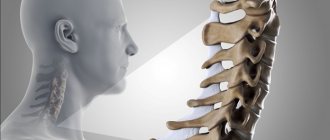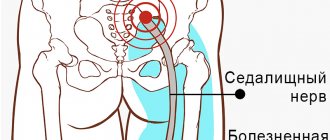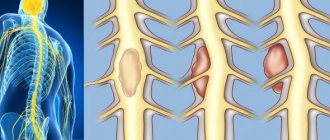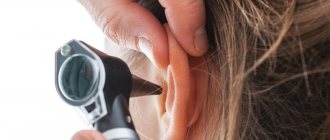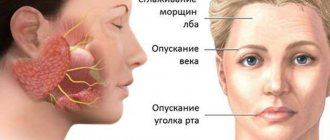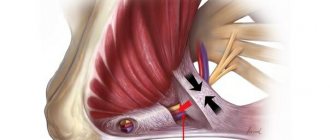Sharp pain in the chest area, radiating to the arm or under the shoulder blade, can be associated with both pathologies of internal organs and intercostal neuralgia. But most often in young and active people, such sensations occur when the thoracic spine is pinched, followed by compression of the radicular nerves and their branches.
Also in the thoracic spine, large blood vessels located in the spinal canal can be pinched. They are responsible for the blood supply to the structures of the spinal cord and their membranes, outgoing roots, etc. Pinching of blood vessels when discs are displaced or protrusion develops is dangerous to life and health. Spinal cord ischemia can lead to the development of a spinal stroke and paralysis of the human body.
Sudden pinching of the thoracic spine is a reason to urgently seek medical help. You can contact a neurologist or vertebrologist. These doctors will help make an accurate diagnosis and try to relieve the acute pain syndrome that inevitably develops with such a condition.
The proposed material describes the characteristic symptoms of pinching of the thoracic spine and treatment, which can be carried out using manual therapy methods. If you see a doctor at an early stage of the disease, you can avoid the need for surgery to restore the normal structure of the spinal column.
In Moscow, you can make an appointment for a free appointment with a neurologist and vertebrologist at our manual therapy clinic. Here you will receive experienced doctors who will make a diagnosis and develop an individual course of treatment. Call the administrator and make an appointment at a time convenient for your visit.
Causes of the disease
In general, all reasons can be divided into two groups. Namely:
- Mechanical damage.
- Degenerative processes.
In the first case, it is enough to turn or bend over unsuccessfully to encounter manifestations of pinching. Also, sometimes pathology is provoked by excessive physical exertion and lack of dosage of work and rest. Degenerative processes include scoliosis, osteochondrosis and other diseases. They lead to disturbances in the structure of the vertebrae and the cartilage between them, accompanied by severe pain and a host of other manifestations.
Physical exercise
Symptoms of a pinched nerve in the thoracic spine can easily arise if, for example, you take on a load that is too heavy for you. You may experience pain if you lift a load too quickly or if you lift it incorrectly and put strain on your back.
Osteochondrosis
It is a dangerous disease, the manifestation of which is often a pinched nerve in the thoracic spine. The pathology causes the cartilage tissue between the vertebrae to wear out and become thinner, which significantly impairs shock absorption. Untimely treated osteochondrosis can lead not only to pinched nerves, but also to the occurrence of intervertebral hernia.
Sensitivity of nerves
The sensitivity of the nerves tends to change over time, and the position of the spine changes in the same way. There are cases when, with age, people experience various types of curvature of the spinal column, which provokes pinched nerves. To eliminate this condition, you will need to stop the displacement and strengthen your back muscles.
Symptoms
The symptoms of this phenomenon can be either obvious or disguised as diseases of internal organs and other pathologies. Often, treatment for a pinched nerve in the thoracic spine is needed by people who have gone to the doctor with complaints about the heart, stomach and other internal organs, since the pain innervates them. It is worth knowing how a pinched nerve manifests itself in order to recognize the condition in time and consult a neurologist
.
Chest pain
Symptoms of pinching in the thoracic spine are often very similar to symptoms of an angina attack. The person complains about the following:
- there is severe pain and burning under the shoulder blade and in the chest;
- there is not enough air and you can’t breathe in completely;
- hands go numb;
- Cold sweat appears on the body.
To exclude the condition that occurs with angina pectoris, you can put two nitroglycerin tablets under your tongue. If you have heart problems, this remedy will eliminate them within 5 minutes, but if you have a pinched nerve, then the situation will not improve. In this case, there will be severe pain in the vertebral area.
Problems with the gastrointestinal tract
A person who is experiencing digestive problems due to back pain may need to find out what the symptoms and treatment of pinched thoracic spine may be. A person may note:
- Pain in the intestines when trying to change position.
- Spasmodic pain in the abdomen.
- Stool disorders.
Such symptoms may indicate not only pinching, but also a more serious condition - prolapsed intervertebral hernia or displacement of the vertebrae.
Signs and symptoms of a pinched nerve
The autonomic and sensory nerves are considered the most vulnerable. When one of them becomes pinched, a throbbing and periodically tingling pain occurs in the cardiac region. It becomes difficult to breathe. If you try to take a deep breath, the pain will increase sharply. The symptoms are similar to a heart attack, but the cause is neuralgic. And if you take heart medications, there will be no relief.
There is severe stiffness in the chest area. It becomes more pronounced when a person tries to make any movement. Localization of pain is felt from the ribs to the spinal region. Sometimes it is accompanied by heart rhythm disturbances. This often leads to an erroneous diagnosis when neuralgia is mistaken for a heart attack or ischemia. A pinched nerve, unlike heart problems, is accompanied by long-term painful sensations that cannot be relieved by medications.
If the nerve is severely compressed, stomach pain may be added to the rest of the symptoms, which resemble gastroenteritis, colitis, or ulcers. You can eliminate these diseases yourself. It is enough to take an antispasmodic. If it helps alleviate the condition, then the problem is gastroenterological in nature. Otherwise, the pain is caused by neuralgia. The occurrence of unpleasant sensations in muscle tissue further worsens a person’s well-being. This is caused by a backlash. If the nerve is pinched, the muscles contract convulsively, greatly increasing the pain.
Pinching may be episodic. In other words, instead of prolonged pain, a person is tormented by attacks that differ in the nature of symptoms and duration. Often neuralgia can occur at night, when the body is at rest. The nerve often becomes pinched during moments of taking a relaxed position, when the muscles are not overstrained.
How to treat?
It is necessary to choose a treatment method depending on what preceded the pinched nerve in the thoracic spine. However, there are general rules for treating pinched nerve roots that will help you get rid of the unpleasant condition.
Drug treatment
If you go to the doctor with complaints of back pain and you are found to have an injury, you will be prescribed a list of medications. These will be:
- antispasmodics;
- drugs to improve blood circulation;
- medications for inflammation;
- vaso-strengthening.
Additionally, painkillers may be prescribed depending on the general condition of the patient. As soon as the condition improves, other treatment methods can be used.
Physiotherapy
Physiotherapy is combined with gymnastic exercises, which allow you to recover and prevent recurrent injuries in the future. If you are experiencing pinching in the thoracic spine, you may be prescribed physical therapy:
- ultrasonic;
- laser;
- electrical stimulation of muscle tissue.
However, all these treatment methods can be used only after the patient’s general condition has improved and pain has been relieved.
Surgical intervention
As a rule, during the treatment of pinched nerve tissue, surgical interventions are avoided. But they will be indicated in a number of cases when there is no improvement in the condition for a long time, and the situation is getting worse. Radical treatment methods will be indicated if:
- conservative treatment was not effective;
- the pain spread further;
- the muscles began to atrophy;
- complications have appeared that affect the functioning of internal organs;
- pathological processes occurred in the intervertebral discs.
In such a situation, in addition to surgically eliminating the cause of the pain, surgery may be necessary to enlarge the hole in the intervertebral disc. But most often, treatment with medications and exercises for severe pinching of the thoracic spine can achieve the desired result, and surgery is a last resort.
Treatment
It is prescribed exclusively after an accurate diagnosis and identification of the root cause due to which the damage or compression of the nerve endings occurred. Regardless of what gave the impetus, there are some general actions characteristic of treating this neuralgic problem.
The main goal of therapy is to release and restore the functionality of the compressed nerve. Manual therapy helps a lot. A light acupressure massage can help relieve the condition by weakening muscle tone. For some, one session is enough to relieve pain.
It is impossible to talk about a complete recovery if the pain has subsided. It may come back again, but in a more advanced stage. It is necessary to eliminate the reason why the pinching occurred. Otherwise it will repeat itself again.
People with osteochondrosis need to constantly monitor their condition. The disease cannot be left unattended. You should definitely visit a neurologist to get examined. If this is not done, a pinched nerve can occur at absolutely any time.
The most commonly prescribed medications are antispasmodics and drugs aimed at strengthening the walls of blood vessels and improving blood circulation. The former allow the muscles to relax, which relieves pain. If the case is truly advanced, the patient is prescribed to wear a fixation corset.
After pain is relieved, light exercises and manual therapy are prescribed. Both measures allow the spine to restore its lost functions, return to its natural state, and prevent muscle spasms. Patients who have been diagnosed with a hernia should discuss the possibility of undergoing surgery to remove it with their doctor. Without surgical intervention, pinching and pain in the thoracic region can be regular.
It is impossible to get rid of a pinched nerve ending in the chest if the root cause has not been eliminated. By suppressing the pain syndrome, they only delay the onset of more serious consequences. If treatment is not approached correctly and in a timely manner, this can lead to paralysis and disability. This also applies to osteochondrosis. The progression of the disease leads to irreversible wear and tear of bone tissue.
When your back hurts, rest and therapy are needed. Treatment procedures, if you listen to the advice of specialists, should be completed twice a year. Often, to maintain the normal condition of the spine, so as not to suffer from pain anymore, once a year is enough.
Physiotherapy
Helps quickly relieve pinched nerve endings in the chest area. Special exercises can be done both during the chronic course of the disease and during exacerbation. The main thing is, if pain appears during exercise, stop the activity and take a comfortable position.
The therapeutic complex includes the following exercises:
- They sit on a chair. Straighten your back. Place your hands on the back of your head and bend. The spine is pressed against the upper part of the back, bending back and leaning forward. Repeat the movement 4 times. When bending back, inhale, and when bending forward, exhale.
- Get on all fours, fix the position of the spine. The head is held straight, which helps align the spinal column. They begin to bend and arch their back. The cervical spine should continue with the spine. It is recommended to do from 5 to 8 repetitions per cycle. Each deflection must be accompanied by a return to the original position.
- Lie on your stomach. Hands, palms resting on the floor, are placed next to the body. Raises the upper body. The legs remain on the floor and do not rise. The number of recommended repetitions is 5-8. The head should not be thrown back too far at the highest point. The thoracic region should stretch precisely due to arching.
- Lie on your back. The head, neck and body are raised, the legs are lifted off the floor surface. At one time you need to do from 8 to 10 repetitions.
The complex is quite simple, but effective.
How to get rid of an intervertebral hernia in the thoracic spine without surgery? — Vadim Tanasiev
Prevention
In order not to think about how to remove pinching in the thoracic spine, prevent pathology. Maintain good posture, keep your weight under control, lift weights correctly - do not bend over, but squat. If your work involves a computer or long periods of sitting at a desk, do exercises and breaks. In addition, you need to monitor your diet, adequate intake of vitamins and minerals, basic physical activity, and lead the healthiest lifestyle possible. In this case, it will be possible to maintain the health of the spine even in old age.
